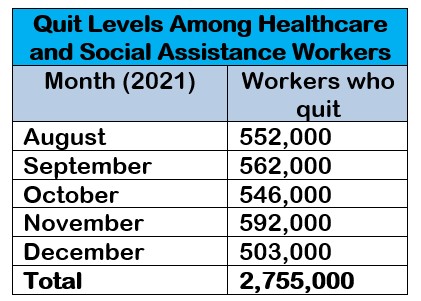Labs need to rethink recruitment tactics to successfully hire younger workers
We’ve heard a lot anecdotally about the “Great Resignation”—a labor phenomenon rooted in the pandemic that has led to an abnormally large amount of workers, including lab professionals, quitting their jobs.
The trend has hit healthcare hard, as evidenced by the latest numbers from the U.S. Bureau of Labor Statistics. From August 2021 through December 2021, the healthcare and social assistance workforce saw nearly 2.8 million workers quit—an average of 551,000 people each of those months. By comparison, in December 2020, 419,000 healthcare workers left their jobs.

Anxiety from the pandemic is likely a contributing factor to some job departures. However, in clinical labs, other causes also are behind the abundance of open positions, such as early retirements, graduating individuals experiencing more specialized training programs, and a shift in the way the current working generation views employment, said Tara Luellen, Vice President of Laboratory Director Services at consulting and recruiting firm Lighthouse Lab Services.
“The lab industry has been hurt at the greatest extreme from this Great Resignation just in terms of the dire need for lab roles and the small pool of correctly qualified individuals in many instances,” particularly with COVID-19 testing demand, she noted.
Specialized Laboratory Roles Cramp Further Development for New Hires
Luellen explained that the labor shortage problem is exacerbated because fewer new lab technologists and pathologists are entering the field at the same time that many lab professionals are quitting.
Additionally, younger workers that do go into the clinical lab and pathology industry tend to be trained in specialty areas more so now than the broader training programs of the past.
“We don’t have as many individuals who are more broadly trained; instead, they’re very specialized,” she added. “So, it takes them years working at labs that do a variety of things to gain real-life, hands-on experience with other kinds of testing than that included in their specialty program, in many cases.”

‘They Want to Experience a Community at Work’
For clinical labs and pathology groups looking to fill open roles, it may be time to take action beyond just beefing up salaries.
Instead, look at what motivates lab professionals to come to an organization, Luellen suggested. She’ll explore the topic of how to successfully recruit new clinical lab leaders in further detail at her session during the 2022 Executive War College on April 27-28 in New Orleans.
One piece of advice she offered is for lab recruiters to carefully articulate to job candidates how an open lab director position or similar role may contribute to either the local or medical community. It’s also important to explain what type of culture an organization offers new employees.
“What we’re seeing is a big shift in what people are looking for,” Luellen said. “The compensation still has to be there, but it’s also a whole community that these people are looking for.
“They’re looking for more than just a 9 to 5, punch the clock, and go home gig,” she continued. “They want the job to enrich their lives. They want to experience a community at work. It’s a different paradigm in how they look at what work means for them.”
—Scott Wallask
Related Information:
Bureau of Labor Statistics: Quits levels and rates by industry and region



